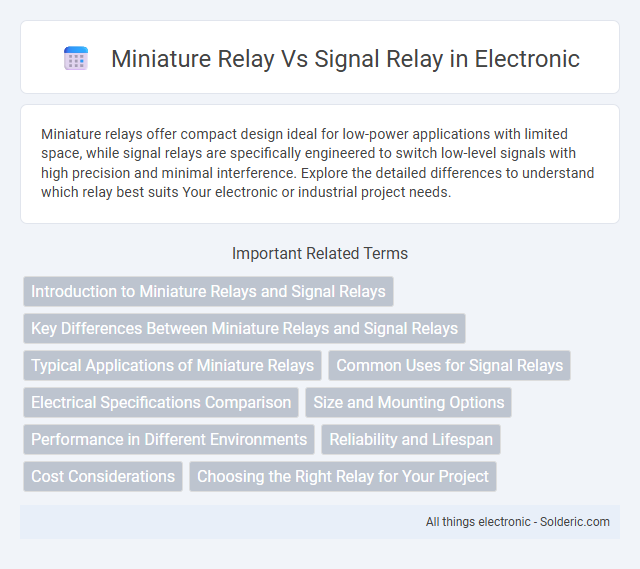Miniature relays offer compact design ideal for low-power applications with limited space, while signal relays are specifically engineered to switch low-level signals with high precision and minimal interference. Explore the detailed differences to understand which relay best suits Your electronic or industrial project needs.
Comparison Table
| Feature | Miniature Relay | Signal Relay |
|---|---|---|
| Size | Compact, but larger than signal relays | Very small, optimized for compact circuits |
| Operating Voltage | Typically 5V to 48V coil voltage | Low voltage, usually 5V or less |
| Contact Rating | Higher current capacity (up to 10A or more) | Low current capacity (up to 1A) |
| Application | Power switching, general purpose | Signal switching, low power electronics |
| Contact Configuration | SPDT, DPDT common | SPST, SPDT mainly |
| Isolation | Good electrical isolation | Excellent for sensitive signal paths |
| Response Time | Moderate | Faster switching suitable for signals |
| Cost | Moderate | Lower cost |
Introduction to Miniature Relays and Signal Relays
Miniature relays are compact electromechanical switches designed for low-power control applications, typically handling currents up to 10 amps. Signal relays operate at even lower power levels, often switching milliamps or less, and are optimized for precision signal processing in telecommunications and instrumentation. Both types provide electrical isolation and fast switching capabilities, but signal relays emphasize minimal contact resistance and low-level signal integrity.
Key Differences Between Miniature Relays and Signal Relays
Miniature relays typically handle higher current loads, ranging from 5 to 20 amperes, making them suitable for power switching applications, whereas signal relays operate at much lower currents, often below 1 ampere, optimized for precise signal control. The coil voltage of miniature relays usually spans 5 to 48 volts DC, supporting robust operation, while signal relays often utilize lower coil voltages, improving sensitivity for low-level signal switching. Miniature relays feature larger contacts and a more durable mechanical design to withstand frequent switching and higher electrical stress, unlike signal relays which focus on minimal contact capacitance and fast response to maintain signal integrity.
Typical Applications of Miniature Relays
Miniature relays are widely used in telecommunications, measurement devices, and in control circuits for their compact size and reliable switching capabilities. They are ideal in applications requiring low power consumption and precise signal control, such as in automation systems, medical equipment, and security systems. These relays provide efficient operation in environments with limited space and demand high switching performance.
Common Uses for Signal Relays
Signal relays are commonly used in low-power applications such as telecommunications, audio equipment, and control circuits, where precise signal switching is crucial. They are designed to handle small voltages and currents, making them ideal for sensitive electronic systems requiring fast and reliable switching. Unlike miniature relays that often manage higher power loads, signal relays excel in preserving signal integrity within complex circuitry.
Electrical Specifications Comparison
Miniature relays typically offer lower coil power consumption and faster switching speeds, making them ideal for compact applications requiring efficient performance. Signal relays handle lower voltage and current levels, often optimized for sensitive low-level signals with high isolation and minimal contact resistance. Your choice depends on electrical specifications such as coil voltage, contact rating, and switching frequency to ensure compatibility with your circuit's requirements.
Size and Mounting Options
Miniature relays offer compact size and a variety of mounting options including PCB, panel, and DIN rail, making them ideal for space-constrained applications. Signal relays are generally smaller, designed specifically for low-current signals, and typically provide PCB mounting, optimizing your circuit board layout for control signals. Selecting between these depends on your space requirements and the mounting flexibility needed for your electronic design.
Performance in Different Environments
Miniature relays offer reliable performance in compact electronic devices with limited space, excelling in low-current and low-voltage applications, while signal relays are designed for precise switching of small signal currents in sensitive electronic equipment. Miniature relays typically provide better durability and can handle higher power loads, making them suitable for environments with moderate electrical stress and vibration. Your choice depends on the environmental conditions and specific electrical requirements, as signal relays prioritize signal clarity and noise immunity in clean, controlled settings.
Reliability and Lifespan
Miniature relays typically offer higher reliability and longer lifespan due to their robust construction and ability to handle higher current loads without degradation. Signal relays are designed for low current control signals, which can reduce contact wear but may result in shorter operational life under heavier load conditions. Reliability in signal relays is often influenced by their sensitivity and switching frequency, while miniature relays maintain consistent performance in demanding industrial environments.
Cost Considerations
Miniature relays typically offer lower cost solutions due to their simpler design and smaller size, making them ideal for budget-conscious applications. Signal relays, while sometimes more expensive, provide higher sensitivity and precise control, which may justify the increased investment for specialized tasks. Your choice depends on balancing cost efficiency against the required performance in your specific electronic circuit.
Choosing the Right Relay for Your Project
Choosing the right relay for your project involves understanding the differences between miniature relays and signal relays. Miniature relays typically handle higher currents and voltages, making them suitable for controlling power circuits, while signal relays are designed for low power, high-sensitivity applications such as telecommunications and instrumentation. Evaluating your load requirements, switching capacity, and sensitivity ensures your project operates efficiently and reliably.
miniature relay vs signal relay Infographic

 solderic.com
solderic.com